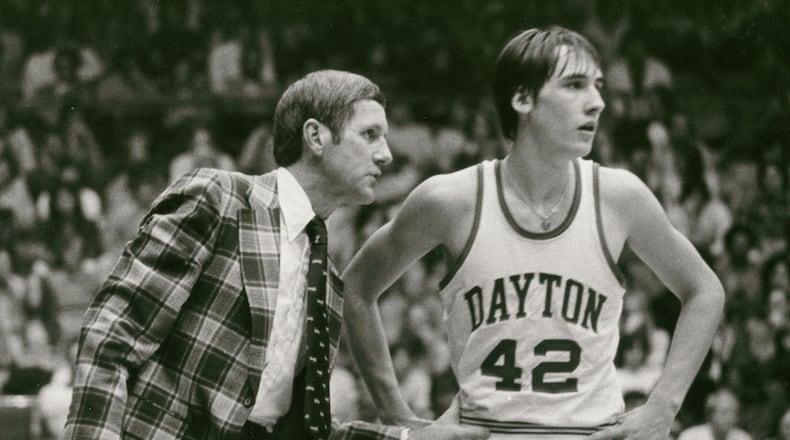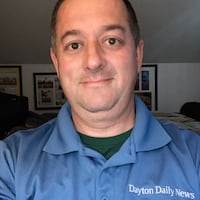“In the end, Jimmy decided Dayton was best suited for his needs,” Burick wrote. “He would be in Dayton but living away from home in a campus dorm. UD offered what he wanted in a business course. And Don Donoher, whom he had known almost from birth, offered credibility when he said Jimmy could be a starter at forward as a freshman.”
Fifty years later, Paxson, now 68, is a Flyer again. He will serve as senior advisor for basketball operations, UD announced Friday.
Dayton athletic director Neil Sullivan talked about the hiring with the Dayton Daily News on Monday. He said Paxson lives in Phoenix but will visit Dayton more often in his new position.
“You’ll see him around,” Sullivan said. “He’s not going to be sitting on a bench for games or be at every game, but there’s no question that he’ll be involved in games here and on the road and have access to film and all that stuff. He’s all in. It’s not an absent role, so to speak. But he doesn’t need to be in the gym every day.”
Sullivan had met Paxson a couple times over the years, but he said they never “talked shop.”
That changed a year ago when Sullivan and Grant reached out to Paxson to exchange ideas about player retention and evaluation.
Sullivan and Grant were preparing for a new era in college athletics. A lawsuit filed by current and former Division I athletes against the NCAA resulted in a $2.8 billion settlement in June and led to colleges paying athletes directly in July. That change came four years after athletes earned the right to profit off their name, image and likeness. The transfer portal also has reshaped the game.
College basketball is still “fundamentally different” from the NBA, Sullivan said, because there are only 30 teams in the NBA and 400-plus players, but some principles of building rosters in the NBA can apply to college basketball in this new era.
For example, how do you split money among 15 players? How much should a star player, like All-American forward DaRon Holmes II, make compared to others? How much should a player like Holmes make as a freshman? Or as a sophomore and junior?
Those were the kind of questions that started the conversations with Paxson.
“He and I talked a couple times and he was in town a time or two, and he was very helpful,” Sullivan said. “Then I just thought we should formalize that relationship.”
Paxson averaged 18.0 points in 108 games for Dayton. He ranks fifth in UD history in scoring (1,945) and likely would have finished his career as the program’s all-time leading scorer, passing Hank Finkel (1,968) and Don May (1,980), if he had not missed five games in his senior year with a shoulder injury.
After being drafted 12th overall by the Portland Trail Blazers in 1979, Paxson spent 11 seasons in the NBA. He played 8½ with Portland before being traded to Boston in February 1988.
Paxson is UD’s all-time leading scorer in the NBA with 11,199 points. He was an All-Star in 1983 and 1984 and made the All-NBA second team in 1984. He retired in 1990 at 33.
Following his retirement, Paxson returned to Portland in the 1993-94 season as an offensive skills coach. In September 1995, the Blazers promoted Paxson to assistant general manager. Three years later, Paxson took a job as vice president of basketball operations for the Cleveland Cavaliers.
In 1999, the Cavs promoted Paxson to general manager, a job he held until 2005. He had the position when the team drafted LeBron James in 2003. From 2006-2024, Paxson worked as a consultant, scout and director of pro personnel for the Chicago Bulls.
Dayton is the latest A-10 program to hire a famous alum. St. Bonaventure hired famed NBA reporter Adrian Wojnarowski, as general manager in 2024. Davidson hired its most famous alum, Steph Curry, as an assistant general manager in March.
Paxson doesn’t have the general manager title but will have similar responsibilities.
“It’s not about titles or appearances,” Sullivan said. “We want people who have the program’s best interest at heart. There’s no resource, tool, title, person I won’t listen to if we believe they fit that criteria. We’re humble enough to know in this new era you can learn from anyone who brings genuine value.”
Sullivan said Dayton didn’t use the title “general manager” because they didn’t want people to think Paxson would be with the program “every day and running the operations of the entire basketball program, including the coaching staff.”
Adding Paxson to the program gives Sullivan and the coaches a basketball mind who can look at the big picture — something that’s often difficult for coaches to do, especially during the season when they’re preparing for games.
“Recruiting and players are the lifeblood of any program, and I don’t think that will ever change,” Sullivan said. “Coaches wake up every day hunting for talent, but coaches also have to win today. They have 15 players that they need to get better today. Their world is immediate. It’s the next game, the next practice, the next opponent, the next possession.”
What Sullivan has asked Paxson to do, he said, is build an infrastructure that will help Dayton be more deliberate and intentional in how it spends its money on players. He said the core issue is understanding the market.
“For markets to function,” Sullivan said, “both sides of the transaction have to have accurate and relevant information, and really, up to this point, it’s just been a shadow market. Everyone’s just been guessing.”
Sullivan said Dayton will lean on other consultants and software programs in its decision making.
“It’s just starting to take shape,” he said, “But it really is about (Paxson’s) mind, his experience, his connections. Anthony has been able to call him, bounce some things off him. I call him. He shares observations with us. The coaches are in the fire each day. And so I think having someone that can kind of see the whole picture and help us build this out was just something that I thought was worth doing.”
About the Author

